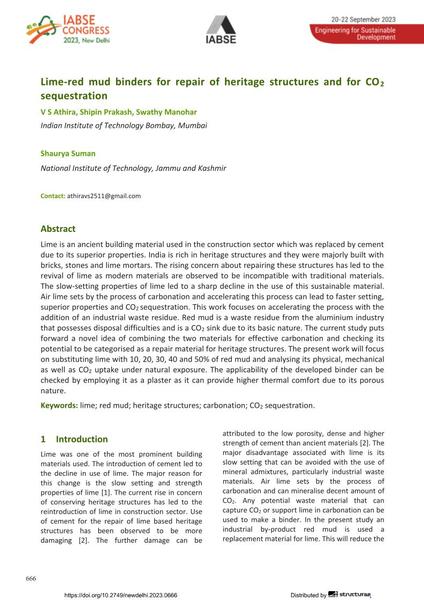Lime-red mud binders for repair of heritage structures and for CO2 sequestration

|
|
|||||||||||
Détails bibliographiques
| Auteur(s): |
V. S. Athira
(Indian Institute of Technology Bombay, Mumbai)
Shipin Prakash (Indian Institute of Technology Bombay, Mumbai) Swathy Manohar (Indian Institute of Technology Bombay, Mumbai) Shaurya Suman (National Institute of Technology, Jammu and Kashmir) |
||||
|---|---|---|---|---|---|
| Médium: | papier de conférence | ||||
| Langue(s): | anglais | ||||
| Conférence: | IABSE Congress: Engineering for Sustainable Development, New Delhi, India, 20-22 September 2023 | ||||
| Publié dans: | IABSE Congress New Delhi 2023 | ||||
|
|||||
| Page(s): | 666-672 | ||||
| Nombre total de pages (du PDF): | 7 | ||||
| DOI: | 10.2749/newdelhi.2023.0666 | ||||
| Abstrait: |
Lime is an ancient building material used in the construction sector which was replaced by cement due to its superior properties. India is rich in heritage structures and they were majorly built with bricks, stones and lime mortars. The rising concern about repairing these structures has led to the revival of lime as modern materials are observed to be incompatible with traditional materials. The slow-setting properties of lime led to a sharp decline in the use of this sustainable material. Air lime sets by the process of carbonation and accelerating this process can lead to faster setting, superior properties and CO2 sequestration. This work focuses on accelerating the process with the addition of an industrial waste residue. Red mud is a waste residue from the aluminium industry that possesses disposal difficulties and is a CO2 sink due to its basic nature. The current study puts forward a novel idea of combining the two materials for effective carbonation and checking its potential to be categorised as a repair material for heritage structures. The present work will focus on substituting lime with 10, 20, 30, 40 and 50% of red mud and analysing its physical, mechanical as well as CO2 uptake under natural exposure. The applicability of the developed binder can be checked by employing it as a plaster as it can provide higher thermal comfort due to its porous nature. |
||||
